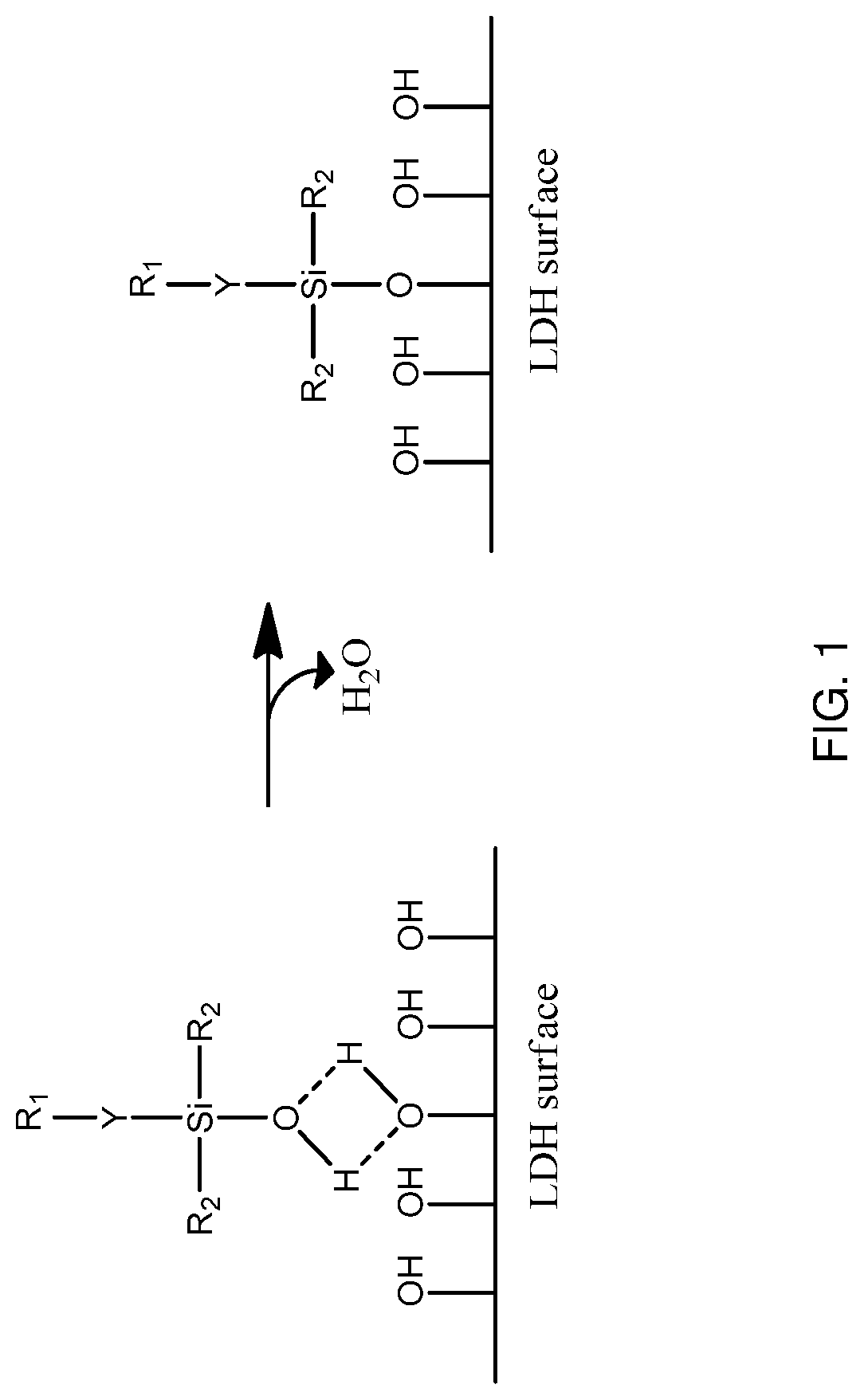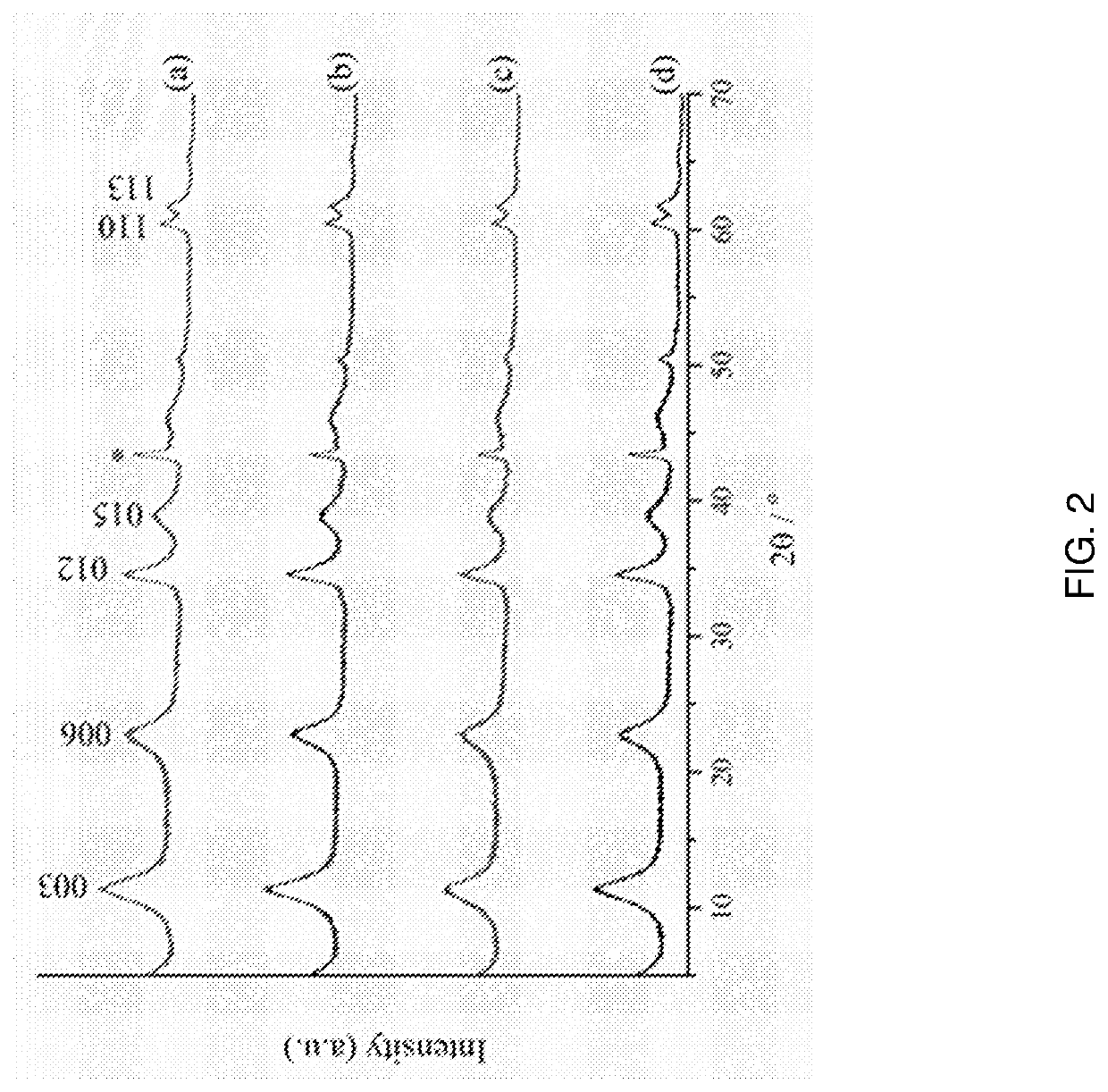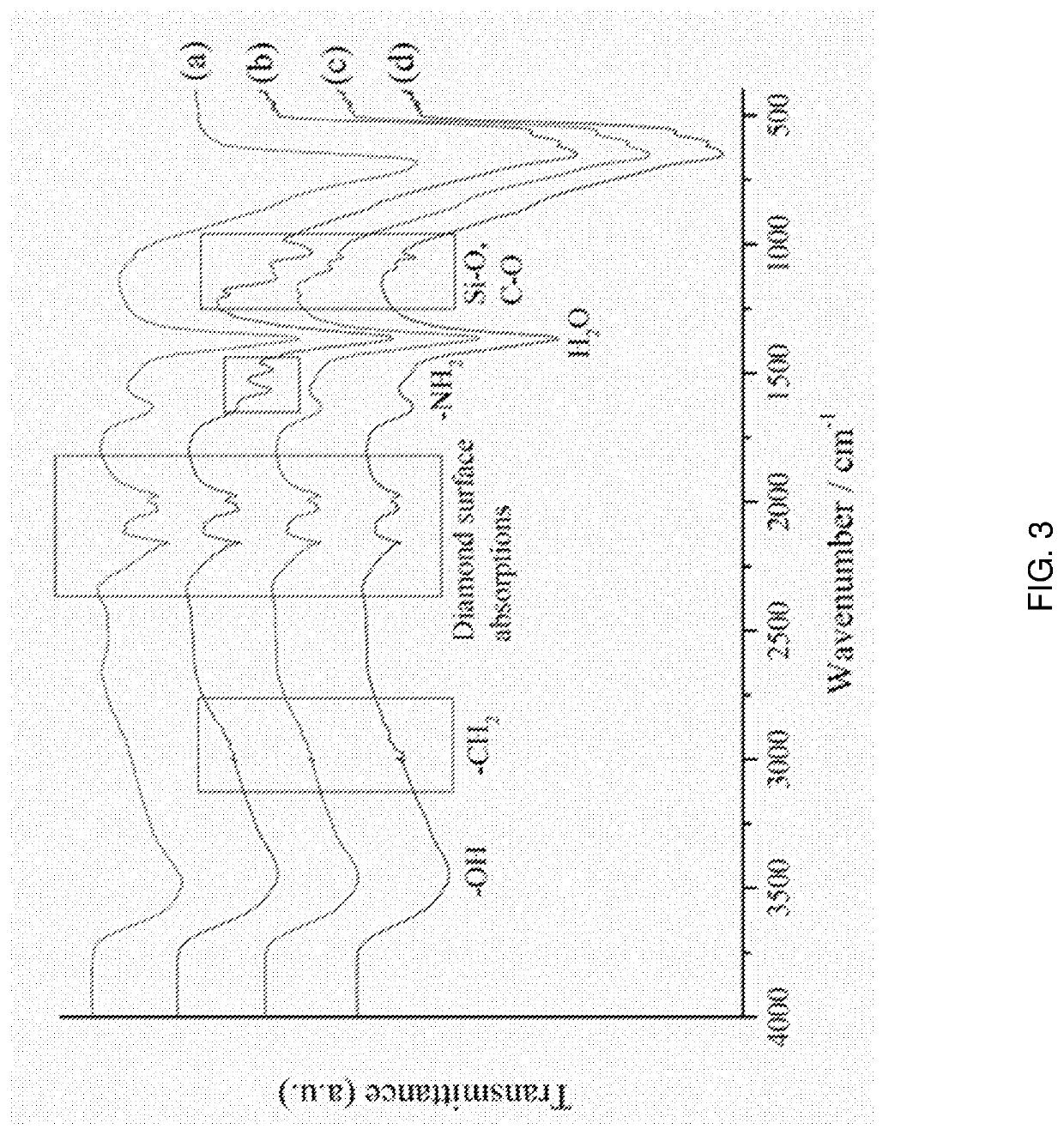Surface modified layered double hydroxide
a technology of layered double hydroxide and modified layered, which is applied in the direction of aluminium compounds, chemistry apparatus and processes, and other chemical processes, etc., can solve the problems of non-porous bodies, “stone-like”, undesirable formation, and often a considerable amount of water in conventionally prepared ldhs
- Summary
- Abstract
- Description
- Claims
- Application Information
AI Technical Summary
Benefits of technology
Problems solved by technology
Method used
Image
Examples
example 1
ON OF LDHS
AMO-LDH-1
[0256]Mg(NO3)2.6H2O (9.60 g, 37.4 mmol) and Al(NO3)3.9H2O (4.68 g, 12.5 mmol) were dissolved in 50 mL of distilled water (Solution A). A second solution was made containing Na2CO3 (2.65 g, 25.0 mmol) and NaOH (4 g, 100 mmol) dissolved in 200 mL distilled water (Solution B). Solution A was added quickly to Solution B and stirred for 30 minutes. The LDH was washed twice with water and once with acetone by centrifuge-washing cycles. Six centrifuge tubes were used at 9000 rpm for five minutes. The resulting LDH slurry was dispersed in 200 mL acetone for 17 hours. The LDH slurry was then filtered, washed with 100 mL acetone and dispersed in 100 mL acetone for one hour. This procedure was repeated three times. The resulting LDH was dried overnight in a vacuum oven.
AMO-LDH-2
[0257]The mixed metal solution was prepared from 9.6 g of Mg(NO3)2.6H2O, 4.7 g of Al(NO3)3.9H2O (4.68 g, 12.5 mmol) in 50 mL of de-carbonated water (Solution A). A second solution contained 2.65 g of ...
example 2
ION OF LDHS
2.1—Synthesis of Orqanosilane-Modified LDHs
[0258]For organosilane modification, different silicon reagents were used; 3-aminotriethoxysilane (APTES), (3-glycidyloxypropyl)trimethoxysilane (GLYMO) and triethoxymethylsilane (TEMS). 1 g of MgAlCO3-LDH (AMO-LDH-1, Example 1) was added to 50 mL of ethanol with stirring. A solution of 14 mmol of silicon reagent in 3 mL solvent (organic or aqueous) was added dropwise to the LDH solution. The resulting solution was stirred at room temperature for six hours. The LDH slurry was then washed three times with ethanol by centrifuge-washing cycles. Four centrifuge tubes were used at 4000 rpm for ten minutes. The resulting LDH was then dried overnight in a vacuum oven.
2.2—Synthesis of Stearate-Modified LDH
[0259]Zn stearate (80 mg) was dissolved in 20 mL of xylene at 70° C. 200 mg of AMO-LDH-2 (Example 1) in 10 mL of xylene was added into Zn stearate solution. The mixture was stirred at 70° C. for 5 min. After cooling to room temperature,...
example 3
ANE MODIFIED LDHS
3.1—APTES-, GLYMO- and TEMS-Modified LDHs
THREE MODIFIED LDHS WERE PREPARED ACCORDING TO THE PROTOCOL DESCRIBED IN EXAMPLE 2.1. THE STRUCTURE OF THE 3 ORGANOSILANE MODIFIERS USED IS PROVIDED IN SCHEME 1 BELOW
[0264]
Scheme 1—Structures of (a) (3-aminopropyl)triethoxysilane (APTES); (b) (3-glycidyloxypropyl)trimethoxysilane (GLYMO); and (c) trimethoxylmethylsilane (TEMS)
Powder X-ray Diffraction (PXRD)
[0265]Structural changes can be observed from PXRD data. If the d-spacing of the 001 peaks is increased from the standard values for MgAlCO3-LDH, this will suggest that the silicon reagent has been inserted into the interlayer space. The PXRD patterns for all the organosilane-modified LDHs are shown in FIG. 2.
[0266]The d003 values for all the organosilane-modified MgAlCO3-LDH are unchanged from the literature value of 7.9 Å for MgAlCO3-LDH. Relative to the PXRD patterns for unmodified acetone washed MgAlCO3-LDH, the LDH patterns for APTES- and TEMS-modified LDH are almost i...
PUM
| Property | Measurement | Unit |
|---|---|---|
| tap density | aaaaa | aaaaa |
| density | aaaaa | aaaaa |
| tap density | aaaaa | aaaaa |
Abstract
Description
Claims
Application Information
 Login to View More
Login to View More - R&D
- Intellectual Property
- Life Sciences
- Materials
- Tech Scout
- Unparalleled Data Quality
- Higher Quality Content
- 60% Fewer Hallucinations
Browse by: Latest US Patents, China's latest patents, Technical Efficacy Thesaurus, Application Domain, Technology Topic, Popular Technical Reports.
© 2025 PatSnap. All rights reserved.Legal|Privacy policy|Modern Slavery Act Transparency Statement|Sitemap|About US| Contact US: help@patsnap.com



